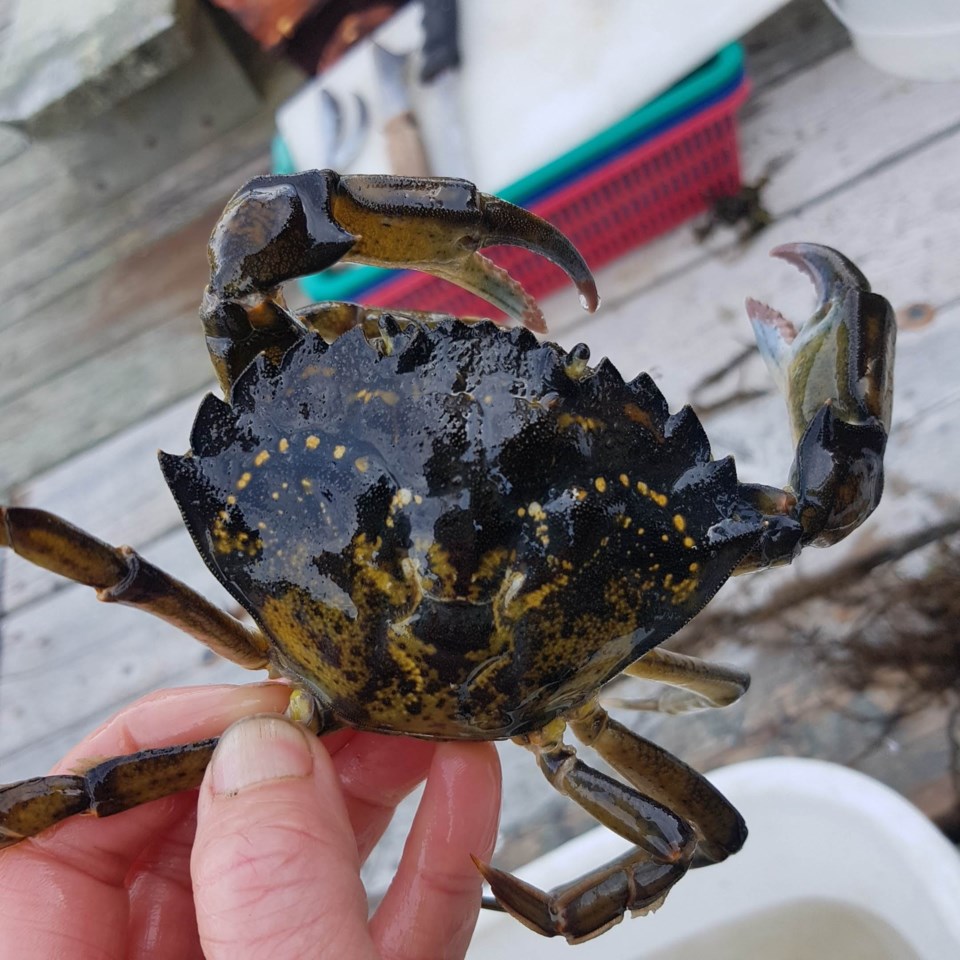Two new captures of European Green Crabs (EGC), an invasive species for B.C.’s coastal waters, were recorded by the Loon Foundation in May 2022. Foundation biologist Jenn Blancard and co-op student Brigid Patterson located the first female crabs captured locally since 2020 on May 16. It was found in a lagoon along Pool Road in the Garden Bay area.
Female may have been sexually mature
Concerning for Blancard, who heads up the foundation’s green crab team, was the size of that crab, at 42mm. She explained “these crabs become sexually mature at a certain carapace size. While there is very little literature as to what that carapace size is, one study suggested that the average size of a sexually mature female EGC was in the range of 37-55mm.”
“She may have been sexually mature and was ready for a mate. They typically mate in the summer and release eggs in the spring.”
According to the Department of Fisheries and Ocean’s website, females of that species can reproduce twice in one season, spawning up to 185,000 eggs at a time.
A second discovery this year of an ECG on the Coast was made by the team on the Pender Harbour side of Canoe Pass. A male 83mm in size was located on May 26.
EGC found on the Coast starting in 2020
Blancard said that in both 2022 incidents, lone crabs were captured. In 2021, two males were captured on the same day in Pender Harbour’s Churchill Bay and a lone male was trapped near the adjacent Francis Point Marine Park a few months later. In 2020, one female was caught in Churchill Bay. That first discovery was made by a member of the public and reported to the foundation.
That first capture launched the team’s work, which is focused in the areas north of Sechelt. The foundation is collaborating with shíshálh Nation and the Sunshine Coast Wildlife Project and hopes to expand monitoring to other areas of the Coast.
“European green crabs are a shore crab. They are found in shallow muddy bays and in areas absent of large crabs,” Blancard said. Her team captures them using folding prawn traps, which are baited and set out overnight in areas where water depths are adequate for the traps to remain submerged, to ensure any fish by-catch are not killed in the trapping process.
All of the crabs captured have been euthanized.
The Invasive Species Council of BC identifies the crabs as a highly invasive species that is spreading in the province’s coastal waters. It states that they are highly damaging to eelgrass beds, which are critical habitat for many species of marine invertebrates and fish, including Pacific herring and salmon.
“While it is unrealistic to stop the invasion, as the larval form of the crabs are carried by currents, it is possible to reduce the probability of the adults finding each other to mate, slowing the invasion,” Blancard said.
How you can help stop the European green crab invasion
“The public is integral to monitoring the invasion. We have put up signs at the Pender Harbour Ocean Discovery Station dock with information about how to identify and report captures. Signs have also been given to our area harbour master for installation at all of the government wharves," said Blancard.
To help with habitat monitoring and protection, the team is asking the public to help by reporting any suspected green crabs that they encounter on the Sunshine Coast. While green crabs range in colour, they have five marginal spines on each side of their carapace from their eye along their side.
If you discover what you think may be a green crab locally, report it to the team by emailing [email protected] or to the DFO invasive species hotline. If possible, take a photo and include it in your email along with the date and location where the crab was found. Do not release the crab until advised it is safe to do so.
In encouraging the public to help with monitoring for invasive species and other foundation initiatives, executive director Michael Jackson told Coast Reporter, “We all hope that things will come round and life in the oceans will thrive again, but it is no use hoping without acting on that hope. If everyone gets together and actively contributes towards change then we will succeed. Come and join us and you’ll see just how much you can do.”



